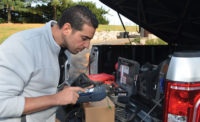HVAC contractors aim to make homeowners comfortable in their own houses. To achieve this goal, a growing number of contractors are extending their attention beyond basic HVAC equipment; they’re considering efficiency improvements to the entire residential structure. Once equipped with the right dose of knowledge and the proper tools, contractors are able to offer whole-house “Goldilocks” solutions: Those that fit just right.
Packing Heat
“Contractors and home-performance auditors are primarily concerned with the energy efficiency, comfort, and safety of a home,” said Kay Wasieleski, vice president, marketing and customer service, Bacharach Inc. They conduct tests to identify areas for improvement and savings. There are a variety of HVAC tools and equipment that assist in the assessment of these factors.”
Tyler Wadsworth, sales manager, P.K. Wadsworth Heating & Cooling, Solon, Ohio, said of the many home-performance tools a contractor should consider, the blower door and manometer serve as vital home-performance factors — especially when used together.
These tools help give “a baseline reading, which will tell you, on the whole, how leaky or tight the structure that you’re testing is. … So, you’ll be able to look at theoretical air changes per hour and match that up to say the ASHRAE standard for ventilation to determine whether the home is tight, leaky, or just right.
“When you put that blower door in conjunction with some of the other tools — the smoke stick and infrared camera, for example — you start learning a lot more about what’s going on in the structure. The blower door depressurizes the home and the smoke stick helps to visualize the leaks in the home,” Wadsworth said.
Chris McKinney, residential sales/building science specialist, BPC Division, Entek Corp., Vancouver, Wash., advised contractors to buy a blower door and duct leakage system and learn how to use them to test duct leakage. “Finding out what a home’s air changes are is powerful,” he said. “If you put the home in negative [pressure] and get your smoke puffer or camera out, you will blow people away.”
Hal Smith, president, Halco Energy, Phelps, N.Y., said thermal imaging, aka infrared (IR) cameras, as well as blower doors, are used on every energy audit, but he warned that proper usage of these tools requires adequate training.
According to Brian Spiker, owner, Aire Serv of Lafayette, Abbeville, La., one reason training is necessary when conducting a home-performance test: homeowner safety.
Ron Auvil, owner, High Performance Mechanical Training and a Fluke-affiliated trainer, said an IR thermal camera is used is to identify heat losses and gains to help determine energy waste.
Another self-explanatory instrument used for taking temperature readings is a thermometer. Lee Bayless, field supervisor/lead refrigeration tech, service dept., Shoffner Mechanical Services, Knoxville, Tenn., said that a contractor should have a digital thermometer to measure supply and return air and superheat and subcooling.
Brian Morrison, product marketing manager, hilmor, said a thermometer, such as hilmor’s Dual-Readout Thermometer, is helpful to contractors on the job because it is manifold-compatible and provides two readings to make calculations simple.
Digital manifolds also assist in figuring out superheat and subcooling. Russ Harju, product manager, Fieldpiece Instruments, said digital manifolds combine pressures and temperatures to calculate superheat and subcooling on an air conditioner automatically. Subcooling and superheat are used to determine the right amount of refrigerant charge in a system; too much or too little will decrease the system’s efficiency, he explained.
Dustin Uptmore, area service manager, Commercial Service, Capstone Mechanical, Waco, Texas, said he recommends contractors have a digital manometer and digital wet stick for taking dry and wet bulb readings and digital manifold gauges that give accurate readings and provide superheat and subcooling readings. In addition, he indicated contractors may need a quality digital multimeter, stating that “they will need to take several readings to provide the customer an accurate evaluation of their system. These tools have the capabilities to provide all of these readings.”
It’s Humid in Here
While temperature is a concern in a home-performance project, so too is humidity. A house that is too dry or humid certainly affects a homeowner’s comfort. Smith indicated that a temperature and humidity meter is needed on this type of project because “you need to measure what you are testing.”
One type of temperature- and humidity-measuring instrument is a digital psychrometer, which determines the temperature drop across the coil and wet bulb, relative humidity, and ambient air temperatures, said Harju.
Louis A. Bellock, director of product management for the instruments division, General Tools & Instruments, pointed out that in addition to measuring dew point, a psychrometer can ascertain air or duct temperature and humidity “to verify that the refrigerant recharge is actually working to cool and dehumidify a particular room or living space.”
He also said the thermo-hygrometer takes readings of basic ambient temperature, humidity, and pressure, which are the primary measurements used to judge system performance and ultimately home-performance cooling and heating efficiency.
Going with the Flow
Bellock said another important element to examine is airflow. “Advanced anemometers can measure air movement as slow as 2 feet per minute all the way up to 8,000 feet per minute. Some models can not only measure airflow, but also convert those readings to airflow measurements and determine air and surface temperatures — including identifying overheated system components.”
According to Harju, there are two applications in which to test airflow. The first is to ensure that the coil in the evaporator is getting enough air across it. To accurately measure it, he said taking the reading inside the ductwork is the best way, and the most common device to take that measurement is a hot wire anemometer. Second, the tech needs to ensure how much air is going to a specific space, and needs a device to measure airflow at the grille, Harju stated. Vane anemometers are commonly used for this, he pointed out.
Adam Gloss, vice president, Bel Red Energy Solutions, Mukilteo, Wash., echoed this thought, stating that he highly recommends vane anemometers and balometers (flow hoods) for home-performance projects.
It’s a Gas, Gas, Gas
Maintaining adequate IAQ is yet another factor in completing home-performance projects. Checks should be performed throughout the process, to ensure the air is clean and healthy.
Auvil indicated that contractors should have air quality meters in their toolboxes to determine if the home has any IAQ issues including carbon monoxide (CO) problems, and ensure adequate ventilation.
Other items to check for include inspecting heating equipment for fuel leaks, improper combustion, and unsafe ambient carbon monoxide (CO) levels, said Wasideski. Tools to perform these tests, such as gas leak detectors, combustion analyzers, carbon monoxide monitors, and more are “critical, must-haves in any HVAC contractor’s toolbox,” said Wasideski.
Smith pointed out that every energy audit his team performs includes CO and efficiency readings using electronic combustion analyzers and electronic combustible gas detectors.
Because CO is dangerous to everyone who comes in contact with it inside a home, one of the tools that Gloss strongly urges other contractors to use is a personal (wearable) CO meter (stick meter), specifically for worker safety.
On Screen
Other tools and instruments that aren’t solely designed for contractors or energy auditors can be beneficial in home-performance work.
Jeff Adams, director of field services, Logan AC & Heat Services, Dayton, Ohio, said iPads can be useful for many applications, including taking video and for visual show-and-tell demonstrations.
McKinney said iPads and iPhones or smartphones help with getting information from a variety of sources, including the Department of Energy (DOE) and utilities, and relaying information to customers.
Energy audits and home-performance contracting are multifaceted and require the use of many tools and instruments. It’s important to intelligently use the proper tools on behalf of your customers’ comfort.
“Never assume what is wrong,” said Spiker. “Prove what is wrong with the right knowledge and tools for the job. If the job is done incorrectly and something is missed, you could put the customer in danger.”
SIDEBAR: The 11 Steps of Home-Performance Work
There’s a lot of work involved in conducting home-performance work, in and around the house as well as when interacting with homeowners. Adam Gloss, vice president, Bel Red Energy Solutions, Mukilteo, Wash., shared the basic steps for these projects:
1. Talk with the homeowner(s) to identify any concerns they have about the comfort, IAQ, health, or safety of the home. Gather as much specific information as possible, including the impact any of these problems have had on their lives. My company uses a standardized survey form for this.
2. Explain the audit process to the homeowner(s), specifically what will be done, step-by-step, why it is done, and what they can expect.
3. Set up the blower door, ensuring no one will enter or leave the home while it is in place. There’s a lot involved in this part of the process.
4. Run the blower door and conduct analysis of envelope and duct leakage using blower door, manometer, flow hood, smoke pencil, infrared camera, etc. A duct blaster also may be used to test duct leakage in conjunction with flow hood and duct mask; this allows you to accurately pinpoint leaks.
5. Using the blower door (moving reference points for manometer), check for leakage from the combustion appliance zone (CAZ) into the living space.
6. Conduct visual inspection of attic, crawlspace, basement, etc. for thermal bypasses, air leaks, insulation levels, duct issues, water damage, venting issues, etc.
7. Test flue/exhaust gases of combustion appliances for proper combustion.
8. Check all exposed gas piping and around the meter for leaks using a gas leak detector.
9. Show the homeowner what you have found. Seeing is believing.
10. Prepare the report(s).
11. Review the problem(s) and propose solutions to the homeowner(s) to correct them, helping the homeowner(s) prioritize your actions based on their needs.
Publication date: 3/3/2014
Want more HVAC industry news and information? Join The NEWS on Facebook, Twitter, and LinkedIn today!







